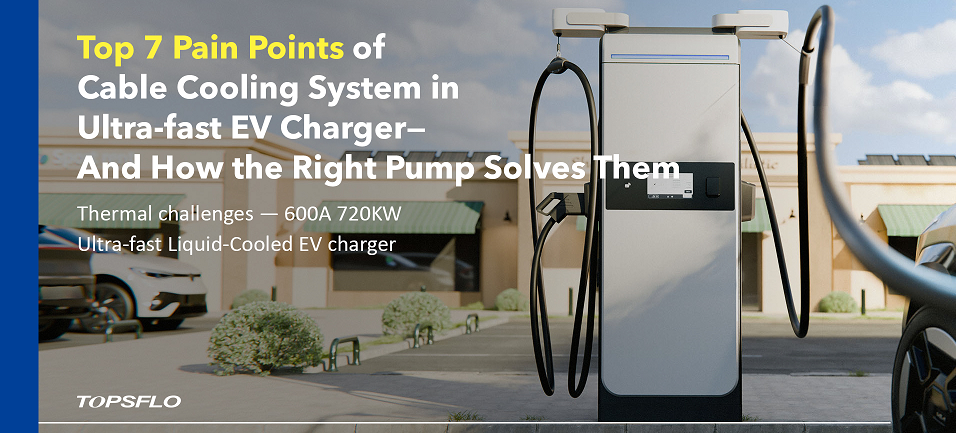Currently, liquid-cooled ultra-fast EV charging stations support a maximum single-cable output of 600A and 720kW, enabling “1 second of charging for 1 kilometer of range” — meeting the rapid charging needs of new energy vehicles (e.g. Huawei liquid-cooled EV charging stations, Tesla V4 Superchargers).

As charging power pushes thermal limits, the liquid-cooled cable system faces urgent demands for lightweight design — yet seven key challenges remain:
Issue: Cable length is often 3–5 meters, with an inner diameter of just 3–6 mm. Flow resistance increases exponentially (ΔP ∝ 1/d⁴).
Result: When pump pressure is low (<3 bar), flow drops sharply, causing cooling failure at the cable end and risk of overheating or damage.
Issue: Different manufacturers use various media (e.g. glycol-water mix, silicone oil, mineral oil), with viscosities ranging from 0.2 to 20,000 cps.
Result: Centrifugal pumps can’t handle high-viscosity fluids. Gear pumps with non-resistant materials (e.g. aluminum + glycol) may fail within 3–6 months.
Issue: Charging current can surge from 250A to 600A, requiring real-time flow adjustment.
Result: Fixed-speed pumps can’t keep up, leading to delayed cooling and surface temperature spikes (measured difference up to 15°C).
Issue: Cables must be light (<1.5 kg/m), but high-pressure fluids (≥6 bar) can cause ordinary hoses to expand or rupture.
Result: Deformation increases pump load and energy use (>20%), with added leak risk.
Issue: At -30°C, fluid viscosity soars (e.g. silicone oil from 50 to 5000 cps); at 60°C, seals degrade.
Result: Poor cold starts, seal failure at high temps, and leakage exceeds industry limits (>0.1 ml/h).
Issue: Traditional pumps rely on manual or open-loop control with >2s response time.
Result: In sudden current changes, cooling lags and cable temperature exceeds safe limits (measured rise up to 25°C).
Issue: No alerts for issues like bearing wear or blockage, leading to sudden failure.
Result: Mean time to repair (MTTR) increases by 48 hours; after-sales costs rise by 40%.
Facing the ultimate challenges of high resistance, high viscosity, and dynamic fluctuations in liquid-cooled EV charging cables, we recommend TOPSFLO magnetic drive gear pump, featuring:
Constant power and stable pressure output to overcome long-pipe pressure drop;
Full corrosion-resistant construction (316L body), compatible with fluids from 0.2 to 20,000 cps;
Intelligent flow control for precise response to dynamic loads, with temperature variation within ±1°C.
Technical specs tailored to solve core pain points
| Pain Point | TOPSFLO Solution | Benefit |
| High pipeline resistance | 8 bar pressure, 5L/min constant flow | 40% higher end-flow, no overheating |
| High-viscosity fluids | Magnetic drive, contactless design
supports 20,000 cps |
Better compatibility
20,000-hour lifespan |
| Poor speed control | 0–100% linear adjustment
0–5V/PWM control |
Smart flow control
15% higher efficiency↑ |
| Slow fault response | 5-level protection:
Over-voltage, over-current, stall, etc. |
70% lower maintenance cost↓
80% faster repair (MTTR↓) |
Recommend you also directly send and email to info@topsflo.com to get our fastest response.
Recommend you also directly send and email to info@topsflo.com to get our fastest response.
